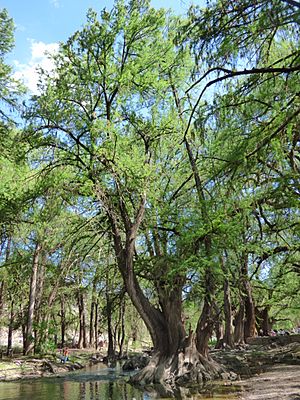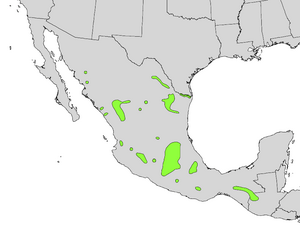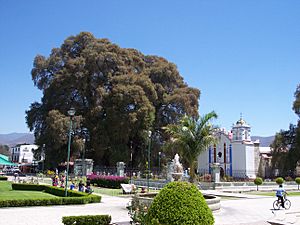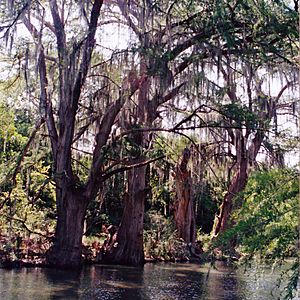Montezuma bald cypress facts for kids
Quick facts for kids Montezuma bald cypress |
|
|---|---|
 |
|
| at El Sabinal, Aguascalientes, Mexico | |
| Conservation status | |
| Scientific classification | |
| Genus: |
Taxodium
|
| Species: |
mucronatum
|
 |
|
| Natural range | |
| Synonyms | |
|
Taxodium distichum var. mucronatum (Ten.) A.Henry |
|
The Taxodium mucronatum, often called the Montezuma bald cypress or ahuehuete, is a special type of tree. It is native to Mexico and Guatemala. The name "ahuehuete" comes from the Nahuatl language. It means "upright drum in water" or "old man of the water." This name fits well because these trees often grow near water.
Contents
About the Montezuma Cypress
This tree is very large. It can grow up to 40 meters (about 130 feet) tall. Its trunk can be 1 to 3 meters (3 to 10 feet) wide. Some trees are even much wider! The leaves are arranged in a spiral, but they twist to look like they are in two rows. They are about 1 to 2 centimeters (0.4 to 0.8 inches) long. The cones are oval-shaped and about 1.5 to 2.5 centimeters (0.6 to 1 inch) long.
Unlike some other cypress trees, the Montezuma cypress rarely grows "knees" from its roots. These "knees" are woody growths that stick out of the ground. Trees found in the highlands of Mexico can become very thick.
One famous Montezuma cypress is the Árbol del Tule in Santa María del Tule, Oaxaca, Mexico. It is known as the stoutest (thickest) tree in the world! Its trunk is an amazing 11.42 meters (about 37.5 feet) wide. There are other Montezuma cypresses that are 3 to 6 meters (10 to 20 feet) wide.
Where Montezuma Cypresses Live
Montezuma cypresses mostly grow along rivers. They can also be found near springs and marshes. These trees grow at altitudes from 300 to 2500 meters (about 1,000 to 8,200 feet). In Mexico, they often grow in highlands between 1600 and 2300 meters (about 5,200 to 7,500 feet) high. The Montezuma cypress can handle dry weather well and grows quickly. It prefers places that are rainy all year or have a lot of rain in the summer.
This tree is native to most of Mexico, reaching as far south as the southern highlands. There are also two separate groups of these trees in the United States. One is in the Rio Grande Valley in southern Texas. The other is in southern New Mexico, near Las Cruces. In Guatemala, you can find this tree only in the Huehuetenango Department.
Cultural Importance

The Montezuma cypress, or sabino, became the national tree of Mexico in 1910. This tree is very important to the native peoples of Mexico. It even appears in the Zapotec creation story. For the Aztecs, the shade of an āhuēhuētl combined with a pōchōtl (a type of Kapok tree) showed a ruler's power.
There is a famous legend about Hernán Cortés. It says he cried under an ahuehuete tree in Popotla after losing a battle called the Battle of La Noche Triste.
How Montezuma Cypresses Are Used
Montezuma cypresses have been used as ornamental trees for a very long time, even before Europeans arrived in the Americas. The Aztecs planted āhuēhuētl trees along paths in the gardens of Chapultepec. This was because the tree was linked to government and power.
The Aztecs also built special floating gardens called chinampas in the shallow lakes of the Valley of Mexico. They made these by adding soil to rectangular areas surrounded by trees like the āhuēhuētl. These trees also lined the canals in the region before the Spanish conquest.
Today, ahuehuetes are often planted in Mexican parks and gardens because they are beautiful. The wood from these trees is used to make things like house beams and furniture. In the past, the Aztecs used the tree's resin to help treat problems like gout, ulcers, skin diseases, wounds, and toothaches. A special liquid made from the bark was used to help the body get rid of extra water. The sticky substance from the wood was used to help with bronchitis. The leaves were thought to help people relax and reduce itching.
John Naka, a famous bonsai master, gave his first bonsai, which was a Montezuma cypress, to the National Bonsai and Penjing Museum in the United States.
Hybrids
Sometimes, different types of trees can be crossed to create new ones. Here are some hybrids of the Montezuma cypress:
- Taxodium × ‘LaNana’ (a mix of T. distichum and T. mucronatum)
- Taxodium 'Zhongshansa' (another mix of T. distichum and T. mucronatum)
Images for kids
-
An 1875 painting, Ahuehuetes en Chapultepec, by José María Velasco Gómez showing the cypress by the lake in Chapultepec.
See also
 In Spanish: Taxodium huegelii para niños
In Spanish: Taxodium huegelii para niños




